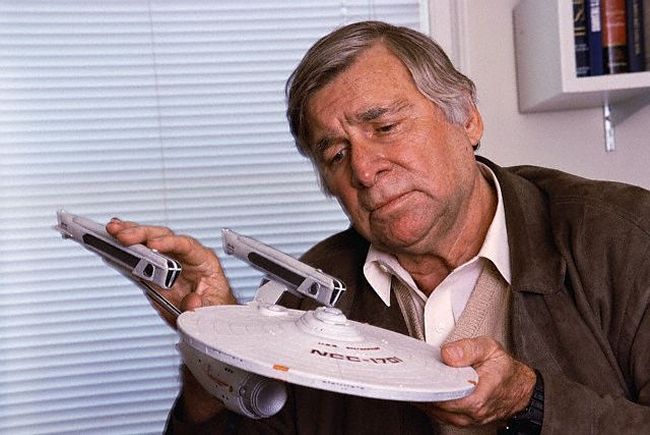Our Most Noble Ideas Given Substance: Star Trek Turns 50
FTC Statement: Reviewers are frequently provided by the publisher/production company with a copy of the material being reviewed.The opinions published are solely those of the respective reviewers and may not reflect the opinions of CriticalBlast.com or its management.
As an Amazon Associate, we earn from qualifying purchases. (This is a legal requirement, as apparently some sites advertise for Amazon for free. Yes, that's sarcasm.)

Critic’s Log 2476.5…I was six when Star Trek: The Motion Picture came out. Talk about old, nobody calls a film based on a television show a “motion picture” anymore, and rightly so—who would pay $40 for a ticket, a bucket o’ popcorn and a bladder-buster sized Mr. Pibb to sit for two-plus hours to watch a picture that doesn’t move? You whippersnappers with your Technicolor and your special effects…ahem! I digress…My father took me to the Cross Keys Theatre in North St. Louis at that impressionable young age. I lasted about 10 minutes before I wanted nothing more to do with it. Not long afterwards Star Wars was re-released ahead of The Empire Strikes Back, and what a difference another six months to a year made! I was a fiend for anything to do with space stuff. Star Wars, Battlestar Galactica, and this goofy old show my grandpa used to make me watch sometimes with this pointy eared dude with a lame haircut. No, I will not release any pictures of my hairstyle circa 1980 until actual Vulcans arrive so they can point at my picture and say, “Your assessment as to the relative attractiveness of Vulcan grooming is…illogical.”
For me, each series brings a little something different to the table. Star Wars was the grand spectacle, pure hero fantasy, good vs evil. Battlestar Galactica was an early warning about mankind creating our own executioner, as we do so often, it seems. As is usually the case—as it was for the original Star Trek series too—ratings ended the show before the show could reach its conclusion, which thankfully was remedied in the terrific modern remake a few years back..
 Star Trek, unlike the others, wasn’t about military coups or surviving the rigors of long space travel with homemade instruments of destruction terrorizing you along the way. It certainly had moments of combat, Naval procedure, the dangers of space itself, but at its core was a beautiful message conveyed in reality here on Earth by one of my heroes, Dr. Carl Sagan. I firmly believe that Dr. Sagan and Star Trek creator Gene Roddenberry shared a vision of the future. A vision where earthlings have put aside our petty grievances with each other on the basis of race, origin, creed, resources, etc. We quit fighting wars, united under one banner, and set off on a voyage to the stars together. Peaceful coexistence among ourselves would of course be the only way to survive war-faring races we’d encounter on the way, from the angry Klingons with their Bat’Leth weaponry (c’mon Michael Maillaro, try to keep up, bro!) and the Romulans with their suspiciously Vulcan appearance. Sagan was constantly upbeat, eager to promote space as a worthy endeavor. Roddenberry was likewise a futurist, presenting a crew of mixed species and mixed races working together during the height of the Cold War.
Star Trek, unlike the others, wasn’t about military coups or surviving the rigors of long space travel with homemade instruments of destruction terrorizing you along the way. It certainly had moments of combat, Naval procedure, the dangers of space itself, but at its core was a beautiful message conveyed in reality here on Earth by one of my heroes, Dr. Carl Sagan. I firmly believe that Dr. Sagan and Star Trek creator Gene Roddenberry shared a vision of the future. A vision where earthlings have put aside our petty grievances with each other on the basis of race, origin, creed, resources, etc. We quit fighting wars, united under one banner, and set off on a voyage to the stars together. Peaceful coexistence among ourselves would of course be the only way to survive war-faring races we’d encounter on the way, from the angry Klingons with their Bat’Leth weaponry (c’mon Michael Maillaro, try to keep up, bro!) and the Romulans with their suspiciously Vulcan appearance. Sagan was constantly upbeat, eager to promote space as a worthy endeavor. Roddenberry was likewise a futurist, presenting a crew of mixed species and mixed races working together during the height of the Cold War.
Think about that for a minute. 1966 was just four years after the Cuban Missile Crisis and three years after the assassination of John F. Kennedy. President Lyndon Johnson was committing America deeper into the war in Vietnam. If you were Russian you were probably a Commie to the average American. Tensions were high. At home, African Americans were still fighting for equal rights and many Asian Americans still remembered being rounded up into camps during World War II. Roddenberry had stones the size of Death Stars, if you’ll forgive the cross-culture analogy. He put the first interracial kiss on television when Captain Kirk and Communications Officer Uhura shared a moment. The Captain’s bridge was regularly populated by a Russian, a Japanese American acted by a gay man, the aforementioned African American, the irascible southern doctor (Bones was from Georgia, studied in Mississippi) and that blue-blooded alien half-breed. Most of the time, they all got along just fine with their bombastic Canadian leader—on screen, anyway.
Look around right now. America is a train wreck on the verge of the least popular election in the history of democratic government. Many races still aren’t treated equally, including women of all colors. Corporate greed around the world is killing the planet, and if they aren’t doing it fast enough we’ll find any trivial reason to mow down a nightclub, start a war over millennia old dinosaur goo, throw stones at children for believing a slightly different version of the same basic Christian beliefs of the stone thrower, and Lord have mercy if you’re way off the track, like the Jews or Muslims! (You get that this is a hyperbolic statement to get a certain point across and I’m not really going all Archie Bunker on you, right? Good! Now go Google Archie Bunker, or better yet, search on YouTube!) We, the people, are never going to Mars, the moon or even our own ocean depths, where the whales apparently know more than they let on, if we don’t stop hating everyone  about everything, real or imagined, and learn to work for a common good. Star Wars probably resonates with us because it’s closest to our reality, but Star Trek is our most noble ideals given substance. It’s humankind at our best, living, working, fighting, and hopefully surviving in unity. And for pretty much the rest of my life since that ill-fated trip to the old General Cinema in 1979, Star Trek has constantly tried to remind us of those ideals. There’s been 13 films to date and you can rest assured there will be more. Television has brought us the adventures the diverse crews of The Next Generation, Deep Space Nine, Voyager, Enterprise, and soon, Discovery.
about everything, real or imagined, and learn to work for a common good. Star Wars probably resonates with us because it’s closest to our reality, but Star Trek is our most noble ideals given substance. It’s humankind at our best, living, working, fighting, and hopefully surviving in unity. And for pretty much the rest of my life since that ill-fated trip to the old General Cinema in 1979, Star Trek has constantly tried to remind us of those ideals. There’s been 13 films to date and you can rest assured there will be more. Television has brought us the adventures the diverse crews of The Next Generation, Deep Space Nine, Voyager, Enterprise, and soon, Discovery.
Maybe this time the message will finally stick. Ritter, out.
“For small creatures such as we the vastness is bearable only through love.” – Carl Sagan


